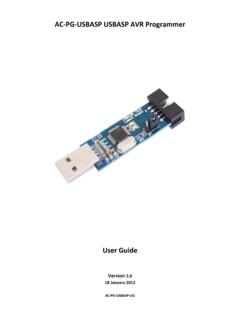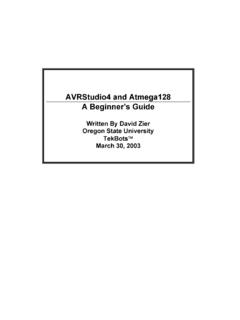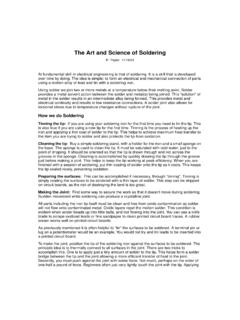Transcription of LTSpice Guide - Oregon State University
1 LTSpice Guide Click on the SwCAD III shortcut created by the software installation. Select File and New Schematic . Add a component Add a resistor Press R or click the resistor button to insert a resistor. If you want to rotate the resistor before placing, press ctrl+R or click the rotate button. Left click where you want to place the resistor. Press esc to quit adding resistors. Add an inductor Press L or click the inductor button to insert an inductor. If you want to rotate the inductor before placing, press ctrl+R or click the rotate button. Left click where you want to place the inductor. Press esc to quit adding inductors. Add a capacitor Press C or click the capacitor button to insert a capacitor. If you want to rotate the capacitor before placing, press ctrl+R or click the rotate button. Left click where you want to place the capacitor. Press esc to quit adding capacitors. Add other components Press F2 or click the component button to insert a component.
2 A Select Component Symbol window will open . Take a minute to browse through the list of available components. Note that sources are labeled as current and voltage . Select the component that you want to add and click OK . If you want to rotate the component before placing, press ctrl+R or click the rotate button. Left click where you want to place the component. Press esc to quit adding this component. Modify Component Values To modify the value of an added component, right click on the component. Enter the value of the component in the default units (ohms, farads, henrys, etc.). The value can also be edited by right clicking on the value of the component shown on the schematic instead of the component itself. For a DC voltage source, enter the voltage and series resistance. For all other voltage sources, click Advanced . Select the type of voltage source and enter the required parameters. ( ). For example, simulate v(t ) = 5 + 10 sin 2 60 + 45 o V for 500 ms (30 cycles) as a transient analysis.
3 This information is shown on the schematic view. To edit the input information, you can right click on the component as above or right click on the value of the SINE information. To simulate this same function using an ac analysis, enter the magnitude and phase offset in the Small Signal AC Analysis fields. Delete a component To delete a component, press the delete button and click the scissors on a component to delete. Press esc to quit deleting components. Move a component To move a component, press F7 or click the move button and left click on the component you want to move. Move the component to the new location, and left click to place the component. Press esc to quit moving components. Add a wire To add a wire, press F3 or click the add wire button. Left click on the starting location, move to the ending location and left click again. If the wire is not straight, click where a 90 degree change in direction is desired.
4 Press esc to quit adding wires. Add ground Press G or click the ground button and click on the schematic to add a ground. Press esc to quit adding grounds. Label a net Press F4 or click the add net button. Type the name of the net and click OK . Click to add the net to the schematic. Simulate To run a circuit , select Simulate from the file menu and Run or click the run button. Transient Analysis Select the appropriate tab for simulation and enter the simulation options and click OK . For the AC source shown above, a Transient analysis would be desired to see the outputs for the desired 500ms. At a minimum, a stop time seconds should be entered because the source was set to 30. cycles. Measurements NOTE: When making any measurements, a single click will add the measurement to the plot, while a double click will erase all existing measurements and plot the selected measurement by itself. Measure voltage To measure a voltage on a node, move the mouse over the node to be measured and click.
5 Note: The voltage probe cursor will appear when the mouse cursor is above an appropriate node. The above method will measure voltage with respect to ground. To measure voltage across a component, click on the positive node to be measured, drag the mouse to the negative node and release the mouse. Measure current To measure the current through a component, move the mouse cursor over the component and click. Note: The current probe will appear when the mouse cursor is above an appropriate component. Average and RMS Voltage/Current After selecting a voltage or current, hold the ctrl button and click on the name of the measurement in the measurement window. A new window will open displaying the average and RMS values. Instantaneous Power To measure the instantaneous power dissipated or supplied by a component, hold the alt key and click on the component to be measured. Average Power After selecting the instantaneous power of a component, hold the ctrl button and click on the name of the measurement in the measurement window.
6 A new window will open displaying the average power. Zoom To zoom in on a measurement, left click and drag the mouse over the area. To zoom back to the normal area, right click and select zoom to fit or press ctrl E . NOTE: When selecting an area, the size of the area can be viewed in the lower left hand corner. AC Analysis To perform an AC analysis, click on the AC Analysis tab and enter the type of sweep, number of analysis points, and the stop and start frequencies. For the voltage source above, we can start by looking only at the response at the frequency of the source. The AC analysis is set to 1 point with a start and stop frequency of 60Hz. When running the AC analysis, a window will open showing the magnitudes and phases of the voltages and currents in the circuit . To view the circuit for multiple frequencies, increase the number of points and set the start and stop frequencies to view the desired frequencies. The voltages, currents, and power can be measured as described above.









